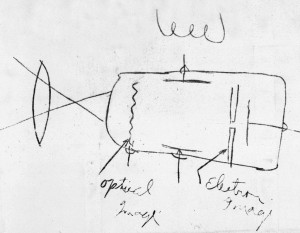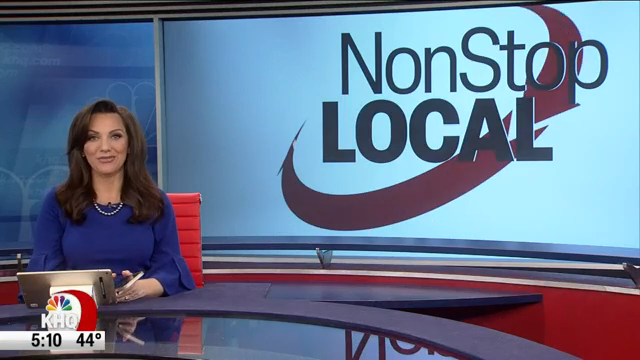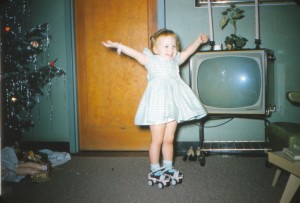Your Assignment
Some of the earliest pictures my parents took of me have a television in the background.
So, television has been around as long as I have.
Well, in truth, the mechanics of TV has been around a lot longer than I have. I’m really a child of early television programming.

The TV mechanism was actually invented by an Utah boy named Philo T. Farnsworth. He first sketched the idea of the vacuum tube in his high school chemistry class. He went on to develop the first electric television set in the 1920s.
The Great Depression and World War II supply shortages stalled the spread of television. The research continued but at a slower rate because materials and man-power were needed for the war effort.
The first television broadcast went out in 1936. There were maybe three television receivers at the time, all in the same building. The people watching were mostly radio executives. It’s fascinating television. I fast fowarded the video a couple of minutes to get you to this incredibly innovative television. Watch a minute or so of it…if your heart can stand the excitement of it all!
I’ll confess. I couldn’t get past 15 seconds of this video before I started to fast forward through it. But think about how AMAZING this was at the time. Television allowed you to see people talking and moving in another room, possibly in another building at the same time you are watching it! Remarkable!
In the wake of WWII, and in conjunction with the Baby Boom and the growth of the middle class, television exploded. There are tons of websites that explore the history of television.
One of the best I’ve found is run by the Archive of American Television (the Emmy people). There are tons of video interviews with the people who made television history. It’s really worth a few minutes to explore. For example, here’s what I found in 15… errr make that 30 minutes of exploring. There’s so much interesting stuff I kept running into. As you can see, there is a wide variety of videos about the history of television on this site.
One of the Ed Sullivan directors talks about the first time the Beatles appeared on the show.
Dan Castellaneta talks about the origins of Homer Simpson’s “D’oh!”
Walter Cronkite on getting the anchor seat at CBS News
The producer of Survivor, Mark Burnett, talks about being a pioneer of reality television.
Paul Shaffer talks about how Sonny and Cher were reunited and sang “Babe” on the Late Show with David Letterman.
Writer/producer Donald Bellisario talks about his hit television shows including Magnum, P.I.; Quantum Leap, JAG and NCIS.
Genie Francis, “Laura” from Luke and Laura fame on General Hospital
Okay, I had to cut myself off. This site is addicting!
Television is changing
Insider Intelligence, a digital data company, promises its clients a peak at the future of television through their data analysis. They say we’ll spend even more time watching digital media, but a smaller chunk of that digital media will be traditional television. What are we watching? We’ll stream shows so often that by 2024 over one/third of American households will no longer have pay TV. (My brother is already one of them.)
Those broadcasting tradition television have found they need to create more local content more often in order to keep viewers in front of the TV screen. For example, in Nashville, 3 of the 4 news stations dropped syndicated programs in favor of more local news.

KHQ-TV’s group includes stations in Spokane, the Tri-Cities and most of Montana. A couple of years ago, the introduced Nonstop Local News. Now you can get KHQ’s news on television, the web and their smart phone app. The philosophy is to prioritize getting news out via digital first. So when a reporter comes back from shooting a news story, their first priority is to write something up or post some kind of video on digital first. Putting their story together for the 6 o’clock news is a much lower priority.
The Netflix Model
Netflix introduced a new method for producing and distributing television that introduced us to “binge watching.” Now binge watching is common place now, but just a few years ago it was revolutionary.
Prior to several people stepping forward to accuse him of sexual harassment, Kevin Spacey pioneered a new style of television that we take for granted today. The star and producer of House of Cards, believed the Netflix model is the future of television. Turns out he was right. (Runs 3:45)
The financial investment website, Investopia, has Three predictions for TV in the next 10 years. They say it will center around choice, interactivity and disappearance of commercials.
The YouTube Influence
On April 23, 2005 this short video about a trip to the zoo was the first to be uploaded to YouTube.
Now, YouTube is the second largest search engine on the Internet behind Google. YouTube has evolved from a on-line service that “steals” television, to a partner with television. What television show doesn’t have a YouTube Channel?
Time Magazine’s Brian Moylan examines YouTube’s impact on television in this short article, A Decade of YouTube Has Changed the Future of Television
Another “vision” of the future of television
I’ve done a lot of research about the future of television, but the strangest version comes from., self-proclaimed “famous new media artist” Jeremy Bailey had a fairly unique vision of what television holds for us in the future. He says we’ll be wearing television on our faces in order to better share what’s important to us as individuals to the public.
I don’t know how feasible his ideas are… but 10 years ago a mobile phone that could surf the Internet, take and share pictures and navigate us to places without a map was pretty “out there” thinking. (Warning: This video may make you dizzy!)
